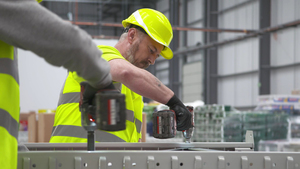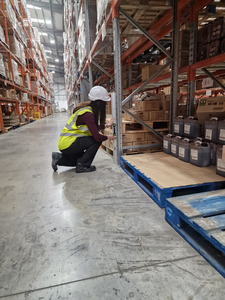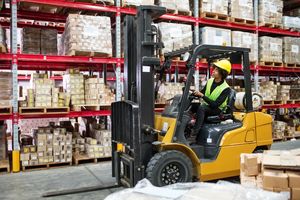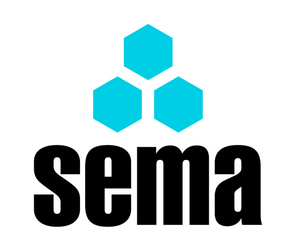

|
Edward Lowton
Editor |


|
| Home> | Handling and Storing | >Training | >Rack safety: Are you taking your responsibility for granted? |
Rack safety: Are you taking your responsibility for granted?
19 October 2023
IT'S EASY to take the racking installed in your warehouse or factory for granted. Let’s be honest, if it’s doing its job correctly that’s exactly what you should be able to do. But here’s the problem, most businesses are completely unaware of the delicate balance between safe racking and something going wrong.

Fortunately, severe collapses in the UK are few and far between but even a small failure of your racking can lead to serious consequences. First, there is the impact on your employees who could be severely injured and in worst-case scenarios lead to loss of life. If you are fortunate and everyone escapes injury, you still need to do due diligence and take the racking out of action. This incurs additional costs through reduced stock availability, time spent moving everything and then getting the equipment fixed.
However, the vast majority of incidents and associated costs are easily avoidable by adhering to two key points - maintenance and training.
Meet your racking responsibilities
When addressing the safety of your system, the first thing to be aware of is that your racking is classed as work equipment. Under PUWER (Provisions and Use of Work Equipment Regulations 1998) you have a responsibility to ensure that your equipment is:
- Suitable for the intended use
- Safe to use
- Inspected
- Maintained in a safe condition
Addressing each one requires you, as the manager, to ensure everyone is aware of their responsibilities.
Is your racking suitable for its intended use?
The first thing to address is the basics. Racking equipment must be correctly designed for its intended role. That means it should work for its location, meet the loading requirements for the weight and type of stock and finally, supports your picking process to avoid any unnecessary damage. Check the credentials of the supplier and the products you are purchasing to see if they have been independently assessed to meet industry and quality standards.
Your chosen racking then needs to be installed correctly to meet exact manufacturer and industry specifications. Many overlook this stage but in fact, the installation is critical to the performance of your racking. Do you know if your installer has been properly trained for the job? Experience doesn’t necessarily come with guarantees of safety or quality and, in reality, most installers learn ‘on the job’ with no formal training. When you consider that even the smallest deviation from design intent when installing racking can affect the structural integrity of the system, the need to have a qualified person on the build becomes crucial.
That is why SEMA set up the Storage Equipment Installers Registration Scheme (SEIRS). The initiative trains installers on the safe and correct installation methods to meet SEMA-defined standards and manufacturer’s specifications. Before receiving their full SEIRS card, installers must pass an assessed element of the course to demonstrate they understand and can install racking safely and accurately. Training never finishes, SEIRS cards are only valid for five years after which installers must undertake a refresher course. Companies can check the credentials of their installers by asking to see their SEIRS card.
Is your racking safe to use?
The structure is up, but to maintain it in a safe condition regular users of the equipment need to have the correct knowledge.
The design of your storage equipment allows for some wear and tear and the inevitable knocks. However, there is a limit to what it can take and damage to racking will reduce its load-carrying capacity. You also need to bear in mind that even minor damage can very quickly develop into a serious issue if not addressed.
To keep it in good working order, staff need to be racking aware. They need to know how to work with the equipment, identify if a problem arises and what processes to take. This means equipping staff with the tools they need to become safety advocates. After all, they use the equipment regularly and are best placed to catch potential problems early.
To help companies to navigate safety in their racking, the HSE produces HSG76 Warehousing and Storage: A Guide to Health and Safety. It is not a legal requirement to follow this best practice document. However, adhering to the advice is usually enough to comply with legislation.
The guidance advises your employees to receive training on the safe operation of racking systems and references the SEMA Racking Safety Awareness Course (RSA). Our training has been developed around SEMA’s guidance and Codes of Practice and is very specific to end users' sites. The course covers the safe operation and use of racking systems, an explanation of load notices and provides examples of damage categorisation and prevention.
Has your racking been inspected?
HSG76 also recommends that companies nominate a Person Responsible for Racking Safety (PRRS). They are responsible for ensuring the racking is correctly used, inspected and maintained. Our RSA course provides the training your employees need to undertake this role including guidance on in-house rack inspections, risk assessment and how to report and record damage levels and action points.
Finally, to meet your legal requirements a professionally qualified racking inspector must inspect your racking either once or twice a year. The inspector will conduct racking and storage condition assessments, reports and recommendations to maintain safety in your workplace.
As a benchmark for the industry, SEMA operates a nationwide network of SEMA Approved Racking Inspectors (SARIs). SARI inspectors are trained and assessed in several areas and disciplines to enhance their competency in practical and cognitive skill sets. Their detailed inspection report will cover the suitability and compatibility of your equipment, rack configuration type and classifies any damage using a traffic light system to indicate actions required and over what timescale.
How do you maintain your racking?
What happens if the inspection process identifies that you require work on your racking? The first thing you need to be aware of is the validity of your racking warranty. Any unauthorised work could dramatically impact the integrity of the structure and will render the warranty null and void.
The obvious solution would be to get the manufacturer out to fix the problem, but this is not always feasible. However, if you bought your equipment from a SEMA member, you could appoint either a SEMA Distributor Company or a SEMA Approved Installation Company. They work closely with manufacturing members and can access their documentation to conduct repair work using SEIRS installers.
It is worth noting that you should take the same approach if you plan to extend your racking to increase storage capacity and reduce the additional cost of renting larger premises. Dovetailing additional storage equipment into your current racking requires significant technical knowledge, and your supplier must work to industry standards and manufacturer’s specifications. Failing to do so could impact heavily on the structural integrity and safety of your equipment and potentially result in expensive remedial costs.
Storage Equipment Manufacturers Association
Tel: 01543 278489
Email: [email protected]
Web: sema.org.uk
- Handling & Storing
- Introduction to overhead lifting
- RTITB Operator of the Year
- Free safety posters
- Practical training
- One million CPC Periodic Training Hours
- Industry leaders join forces to deliver a national apprenticeship scheme
- Apprenticeship rally cry
- Refresh training for forklift drivers
- Up-to-date training essential





















